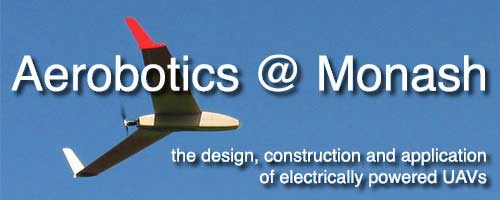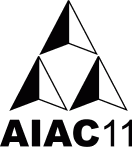
Recent Selected PapersPage Updated August 5, 2005
Monash University's Aerobotics™ Research Group was well represented in a number of papers presented at the Eleventh Australian International Aerospace Congress, Melbourne, Australia, March 13-17, 2005. The following seven papers were presented at the conference.
G.K. Egan, R.J. Cooper and B. Taylor Summary: Research related to unmanned aerial vehicles (UAVs) has become very popular within universities globally largely because of the wide range of engineering challenges they pose. Other researchers are interested in the use of UAVs in support of their own research including environmental monitoring and emergency services. In sparsely populated countries such as Australia there is considerable potential for UAV use, as many missions can avoid the vexed safety issues associated with flight over populated areas. For this potential to be realised in most cases requires aircraft which can be flown with minimal setup and associated training while remaining within the Australian CASR-101 Regulations. Download the complete paper
Calculating Attitude from Horizon Vision
Terry Cornall, Greg Egan Summary: The horizon angle is calculated as a function of the average coordinates for the ground and sky classes and a measure of the aircraft pitch is determined by the displacement of the horizon from the centre of the view. A prototype camera and image processing system has been built and used to test and validate the procedures. Trials of the system in simulation and real flights in a remote controlled glider have been carried out. The results are given and discussed. Download the complete paper
Heaven and Earth: How to tell the difference
Terry Cornall, Greg Egan Summary: This paper discusses two methods for segmenting an image into sky and ground and three metrics for measuring the 'fitness' of the segmentation for the purpose of measuring the horizon angle and position. The reason for doing this is to use the horizon as a reference for stabilising the flight of an Unmanned Air Vehicle. (UAV). Results of applying the methods to video captured by a UAV are presented. Download the complete paper
Real Time Unnatural Object Detection for an In-Flight UAV
Adam Hazeldine, Andrew Ross Price Summary: The determination of natural and unnatural objects in real time from a small lightweight Unmanned Aerial Vehicle (UAV) is the basis of many mission scenarios including detection of ships at sea, vehicles in trees, buildings and other man made objects in a natural environment. The problem with many image processing operations is the time and computing power required. In real-time situations, and on an airborne system with a total weight of less than 5kg, both time and computing power are dramatically limited. With these limitations in mind, it was decided to investigate how well natural and unnatural objects could be distinguished using fundamental concepts and features. While measures such as color are of some use, for example bright red is not a common natural color but fairly prevalent in vehicles such as fire trucks (and Ferraris), they are only of limited use when natural colored objects are actually unnatural objects. This investigation explores detecting unnatural objects based on features other than color. Only simple techniques which required minimal computing were permitted. The results presented in this investigation were tested on poor quality, grainy, distorted footage with low color separation captured from a UAV in flight. Vehicles, buildings, roads and markers were separated from trees, scrub and natural bushland using Commercial off-the-shelf low resolution capture hardware and a typical PC. This research was completed as part of an undergraduate thesis project at Monash University. Download the complete paper
Visual Determination of UAV Attitude In-Flight
Adam Sloan, Andrew Ross Price Summary: Unmanned Aerial Vehicles (UAV's) are finding increased application in both domestic and military applications. Most end users of UAV's are not particularly interested in the flying platform itself, but rather in the destination, the timing, the cost and objectives of a particular mission. Many end users have very little training in aircraft flight, including model or remote controlled aircraft. The idea of a UAV that can be used in a 'set and forget' manner is very appealing, particularly in applications where the user is in a remote location such as outback Australia or the Antarctic. In such cases, having an experienced pilot on standby may be prohibitively expensive. Unfortunately there are substantial risks involved in both launching and landing a UAV. Any damage to the airframe or to sensitive payload equipment may make the use of UAV's in such applications prohibitively expensive. This research examines the use of a typical domestic video camera and Commercial off-theshelf video capture hardware for determining the attitude of a small, under 5kg UAV, while in flight. This research was completed as part of an undergraduate thesis project at Monash University. Download the complete paper
Landing Approach Advisory System for a UAV
Christopher Wilkin, Andrew Ross Price Summary: With the expanding domestic and military application of Unmanned Aerial Vehicles the list of people using these systems becomes very diverse. While some UAV operators may be highly skilled pilots, either of manned aircraft or remote piloted vehicles, the diversity of application, and the remote nature of many fields of operation may mean that an experienced pilot is prohibitively expensive. This places any UAV at great risk particularly during the critical time of landing the aircraft. This paper describes a simple, low-cost, reconfigurable landing approach advisory system that offers a measure of support for aircraft during the last few critical seconds of approach. The system uses commercial off the shelf video cameras and a conventional PC to capture video of the aircraft in real time. The operator is provided with real-time altitude and groundspeed information in the last few critical seconds of landing approach. The progression of this system is to provide a novice operator with an economical, fully autonomous UAV recovery system able to be deployed in any field of operation. This research was completed as part of an undergraduate thesis project at Monash University. Download the complete paper
FPGA Based UAV Flight Controller
Justin Young, Andrew Ross Price Summary: Small scale, light weight Unmanned Aerial Vehicles (UAVs) have very limited payload capacity. Yet the demands for greater mission complexity as well as increased flight performance tend towards increased onboard processing. This research examines the idea of designing a UAV control system in a low cost FPGA device using a custom designed processor core that has been specifically tailored to minimize the sensor interface. Data received by the sensor system is available directly to registers within the processor, and is updated by independent means. The processor is free of data gathering activities thanks to the parallel nature of FPGA design. This approach leads to a compact low cost system that has been optimized toward lightweight UAV control systems. This research has been conducted as part of an undergraduate thesis project at Monash University. Download the complete paper
Previous PapersA Low Computation Method to Determine Horizon Angle from Video - Preliminary version
Terry Cornall Abstract The paper details the work of the author towards the goal of using video processing for autonomous flight control of small unmanned aircraft (UAVs). The work reports on procedures that were designed by the author to determine the roll of an aircraft from video imagery of the horizon, using video and computing equipment small and light enough to be carried by the aircraft. Results of trials using simulated horizon views are given and discussed. Key words. UAV, unmanned aircraft, horizon detection, horizon angle, aircraft attitude, atmosphere, sky, ground, image processing Download the complete paper
Horizon Sensing Attitude Stabilisation: A VMC Autopilot Presented to the 18th International UAV Systems Conference, Bristol, UK, 2003
B. Taylor; C. Bil; S. Watkins
Abstract This paper covers a very simple, low cost absolute attitude stabilisation system based on thermal horizon detection. This stabilisation system is very fast and is ready for operation from a cold start within 20 milliseconds (mS). It consumes very low power and occupies a total code space of less than 6000 words. The system works reliably, day and night, in Visual Meteorological Conditions (VMC) using readily available thermopile sensors in the thermal infrared band between 7.5 and 13.5 microns. One application is a simple photo reconnaissance unmanned aircraft that can be operated by one person. These are flown almost exclusively in VMC as the cameras can rarely function in worse conditions. A second application is to stabilize air vehicles used for research applications by non-pilot students. The operator can concentrate on their own project in machine vision, optic flow, telemetry, video compression, wireless LANs, whatever, without needing to become a competent pilot. One interesting feature of the HSAS is its ability to hold a sensor plate level in both pitch and roll during turns, without the need for any gyros or accelerometers. This greatly simplifies geo-referencing a down looking photograph as the aircraft GPS coordinates are automatically at the centre of the image, regardless of bank angle. A stabilized platform allows development of a much simplified user interface where non-pilots may safely control a UAV with only a few minutes familiarisation. The command system controls the aircraft by one joystick and the ground operator can select proportional right or left turns and whether to climb, hold height or descend. During takeoffs and landings the ground controller merely steers right or left and the climb out or descent is automatic. Download the complete paper
Optic Flow Methods Applied to Unmanned Air Vehicles
Terry Cornall, Greg Egan. Abstract The paper discusses aspects of the potential usefulness and limitations of methods that could use the information in the optic flow of video that can be captured and processed aboard an unmanned air vehicle. Some preliminary theoretical and experimental results from analysis of video that has been recorded by the author using video telemetry equipment designed and constructed by the author and members of the UAV group at ECSE will be presented. Download the complete paper
The term Aerobotics is © Copyright 1999-2004, CTIE
|
